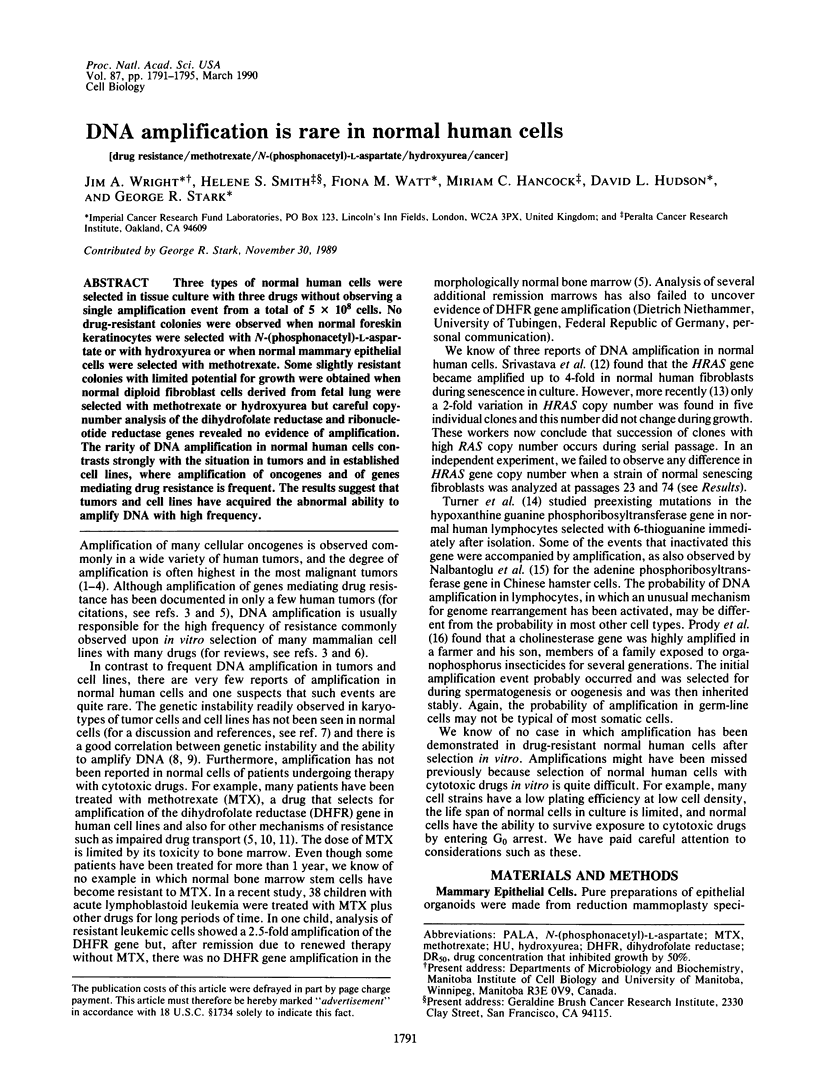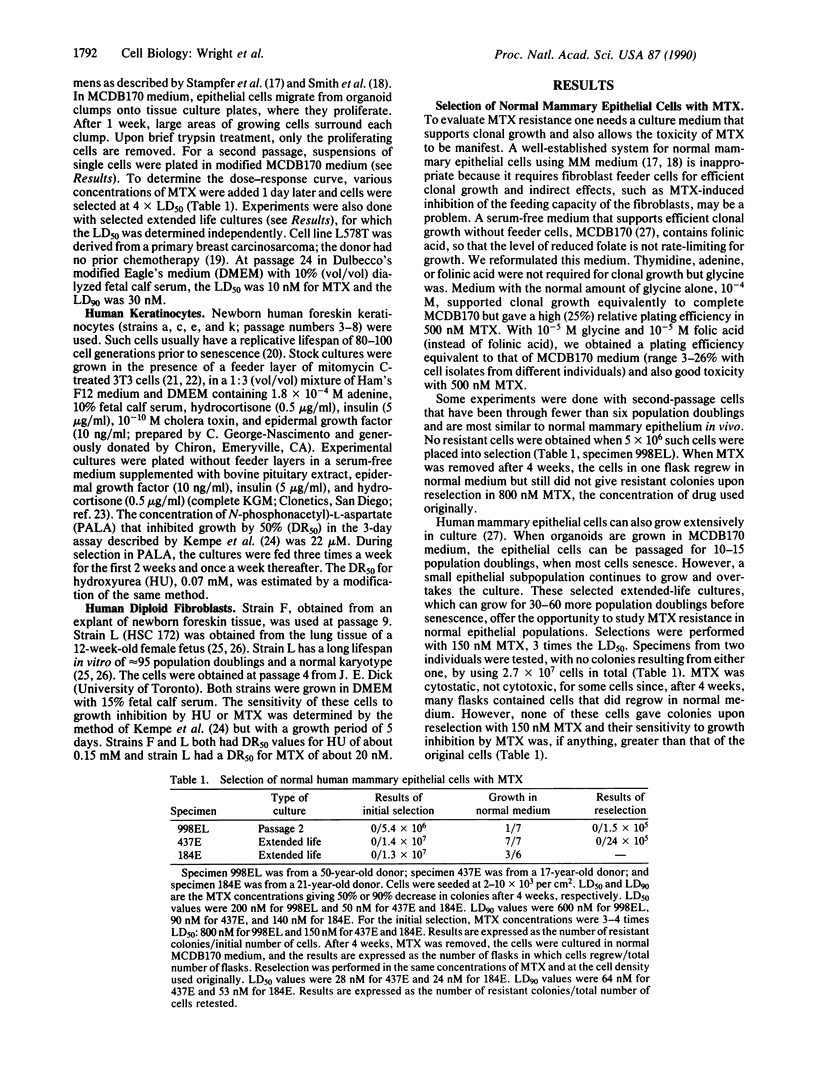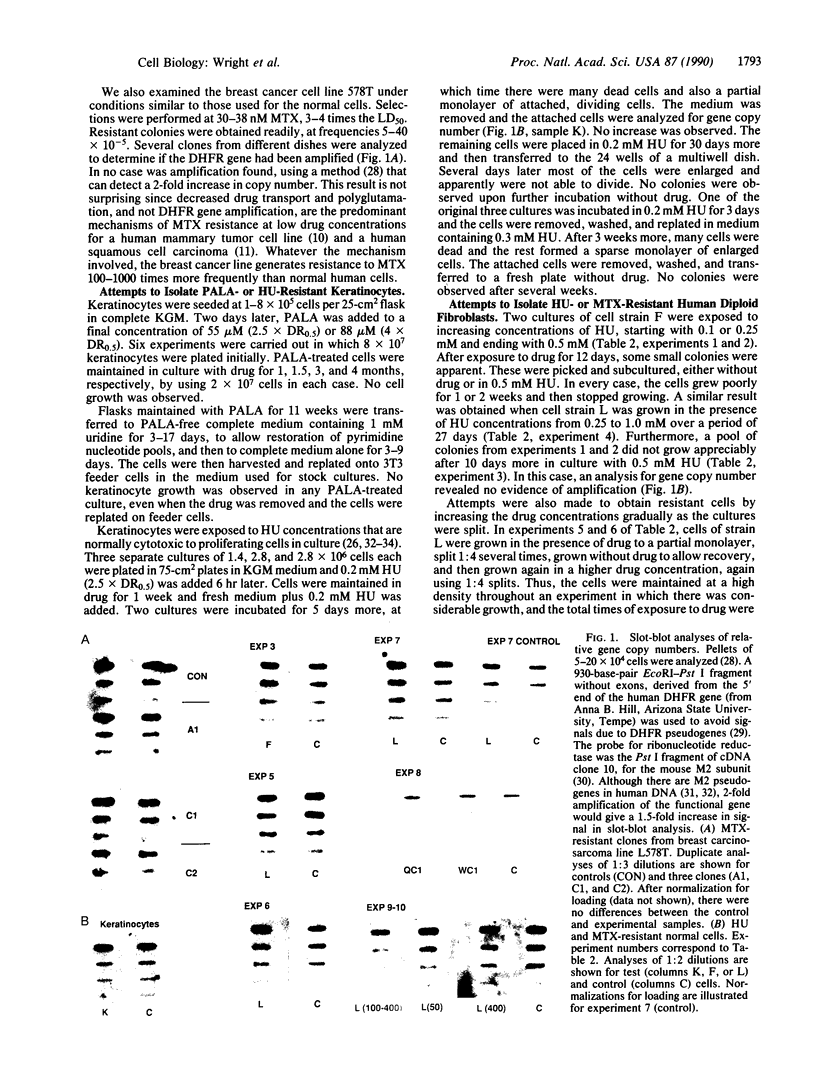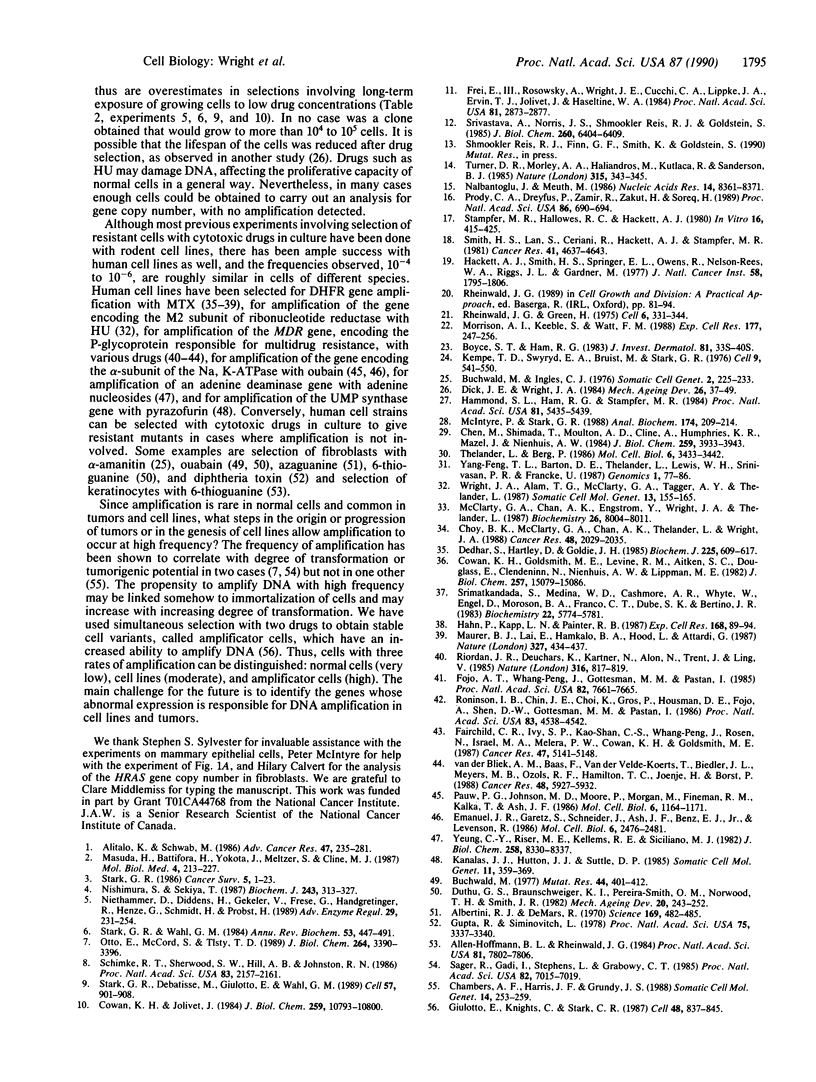Abstract
Three types of normal human cells were selected in tissue culture with three drugs without observing a single amplification event from a total of 5 x 10(8) cells. No drug-resistant colonies were observed when normal foreskin keratinocytes were selected with N-(phosphonacetyl)-L-aspartate or with hydroxyurea or when normal mammary epithelial cells were selected with methotrexate. Some slightly resistant colonies with limited potential for growth were obtained when normal diploid fibroblast cells derived from fetal lung were selected with methotrexate or hydroxyurea but careful copy-number analysis of the dihydrofolate reductase and ribonucleotide reductase genes revealed no evidence of amplification. The rarity of DNA amplification in normal human cells contrasts strongly with the situation in tumors and in established cell lines, where amplification of oncogenes and of genes mediating drug resistance is frequent. The results suggest that tumors and cell lines have acquired the abnormal ability to amplify DNA with high frequency.
Full text
PDF




Images in this article
Selected References
These references are in PubMed. This may not be the complete list of references from this article.
- Albertini R. J., DeMars R. Diploid azaguanine-resistant mutants of cultured human fibroblasts. Science. 1970 Jul 31;169(3944):482–485. [PubMed] [Google Scholar]
- Alitalo K., Schwab M. Oncogene amplification in tumor cells. Adv Cancer Res. 1986;47:235–281. doi: 10.1016/s0065-230x(08)60201-8. [DOI] [PubMed] [Google Scholar]
- Allen-Hoffmann B. L., Rheinwald J. G. Polycyclic aromatic hydrocarbon mutagenesis of human epidermal keratinocytes in culture. Proc Natl Acad Sci U S A. 1984 Dec;81(24):7802–7806. doi: 10.1073/pnas.81.24.7802. [DOI] [PMC free article] [PubMed] [Google Scholar]
- Boyce S. T., Ham R. G. Calcium-regulated differentiation of normal human epidermal keratinocytes in chemically defined clonal culture and serum-free serial culture. J Invest Dermatol. 1983 Jul;81(1 Suppl):33s–40s. doi: 10.1111/1523-1747.ep12540422. [DOI] [PubMed] [Google Scholar]
- Buchwald M., Ingles C. J. Human diploid fibroblast mutants with altered RNA polymerase II. Somatic Cell Genet. 1976 May;2(3):225–233. doi: 10.1007/BF01538961. [DOI] [PubMed] [Google Scholar]
- Buchwald M. Mutagenesis at the ouabain-resistance locus in human diploid fibroblasts. Mutat Res. 1977 Sep;44(3):401–411. doi: 10.1016/0027-5107(77)90098-7. [DOI] [PubMed] [Google Scholar]
- Chambers A. F., Harris J. F., Grundy J. S. Rates of generation of methotrexate-resistant variants in cells temperature-sensitive for malignant transformation. Somat Cell Mol Genet. 1988 May;14(3):253–259. doi: 10.1007/BF01534586. [DOI] [PubMed] [Google Scholar]
- Chen M. J., Shimada T., Moulton A. D., Cline A., Humphries R. K., Maizel J., Nienhuis A. W. The functional human dihydrofolate reductase gene. J Biol Chem. 1984 Mar 25;259(6):3933–3943. [PubMed] [Google Scholar]
- Choy B. K., McClarty G. A., Chan A. K., Thelander L., Wright J. A. Molecular mechanisms of drug resistance involving ribonucleotide reductase: hydroxyurea resistance in a series of clonally related mouse cell lines selected in the presence of increasing drug concentrations. Cancer Res. 1988 Apr 15;48(8):2029–2035. [PubMed] [Google Scholar]
- Cowan K. H., Goldsmith M. E., Levine R. M., Aitken S. C., Douglass E., Clendeninn N., Nienhuis A. W., Lippman M. E. Dihydrofolate reductase gene amplification and possible rearrangement in estrogen-responsive methotrexate-resistant human breast cancer cells. J Biol Chem. 1982 Dec 25;257(24):15079–15086. [PubMed] [Google Scholar]
- Cowan K. H., Jolivet J. A methotrexate-resistant human breast cancer cell line with multiple defects, including diminished formation of methotrexate polyglutamates. J Biol Chem. 1984 Sep 10;259(17):10793–10800. [PubMed] [Google Scholar]
- Dedhar S., Hartley D., Goldie J. H. Increased dihydrofolate reductase activity in methotrexate-resistant human promyelocytic-leukaemia (HL-60) cells. Lack of correlation between increased activity and overproduction. Biochem J. 1985 Feb 1;225(3):609–617. doi: 10.1042/bj2250609. [DOI] [PMC free article] [PubMed] [Google Scholar]
- Dick J. E., Wright J. A. Human diploid fibroblasts with alterations in ribonucleotide reductase activity, deoxyribonucleotide pools and in vitro lifespan. Mech Ageing Dev. 1984 Jul;26(1):37–49. doi: 10.1016/0047-6374(84)90163-5. [DOI] [PubMed] [Google Scholar]
- Duthu G. S., Braunschweiger K. I., Pereira-Smith O. M., Norwood T. H., Smith J. R. A long-lived human diploid fibroblast line for cellular aging studies: applications in cell hybridization. Mech Ageing Dev. 1982 Nov;20(3):243–252. doi: 10.1016/0047-6374(82)90091-4. [DOI] [PubMed] [Google Scholar]
- Emanuel J. R., Garetz S., Schneider J., Ash J. F., Benz E. J., Jr, Levenson R. Amplification of DNA sequences coding for the Na,K-ATPase alpha-subunit in ouabain-resistant C+ cells. Mol Cell Biol. 1986 Jul;6(7):2476–2481. doi: 10.1128/mcb.6.7.2476. [DOI] [PMC free article] [PubMed] [Google Scholar]
- Fairchild C. R., Ivy S. P., Kao-Shan C. S., Whang-Peng J., Rosen N., Israel M. A., Melera P. W., Cowan K. H., Goldsmith M. E. Isolation of amplified and overexpressed DNA sequences from adriamycin-resistant human breast cancer cells. Cancer Res. 1987 Oct 1;47(19):5141–5148. [PubMed] [Google Scholar]
- Fojo A. T., Whang-Peng J., Gottesman M. M., Pastan I. Amplification of DNA sequences in human multidrug-resistant KB carcinoma cells. Proc Natl Acad Sci U S A. 1985 Nov;82(22):7661–7665. doi: 10.1073/pnas.82.22.7661. [DOI] [PMC free article] [PubMed] [Google Scholar]
- Frei E., 3rd, Rosowsky A., Wright J. E., Cucchi C. A., Lippke J. A., Ervin T. J., Jolivet J., Haseltine W. A. Development of methotrexate resistance in a human squamous cell carcinoma of the head and neck in culture. Proc Natl Acad Sci U S A. 1984 May;81(9):2873–2877. doi: 10.1073/pnas.81.9.2873. [DOI] [PMC free article] [PubMed] [Google Scholar]
- Giulotto E., Knights C., Stark G. R. Hamster cells with increased rates of DNA amplification, a new phenotype. Cell. 1987 Mar 13;48(5):837–845. doi: 10.1016/0092-8674(87)90080-8. [DOI] [PubMed] [Google Scholar]
- Gupta R. S., Siminovitch L. Isolation and characterization of mutants of human diploid fibroblasts resistant to diphtheria toxin. Proc Natl Acad Sci U S A. 1978 Jul;75(7):3337–3340. doi: 10.1073/pnas.75.7.3337. [DOI] [PMC free article] [PubMed] [Google Scholar]
- Hackett A. J., Smith H. S., Springer E. L., Owens R. B., Nelson-Rees W. A., Riggs J. L., Gardner M. B. Two syngeneic cell lines from human breast tissue: the aneuploid mammary epithelial (Hs578T) and the diploid myoepithelial (Hs578Bst) cell lines. J Natl Cancer Inst. 1977 Jun;58(6):1795–1806. doi: 10.1093/jnci/58.6.1795. [DOI] [PubMed] [Google Scholar]
- Hahn P., Kapp L. N., Painter R. B. Establishment and characterization of two human cell lines with amplified dihydrofolate reductase genes. Exp Cell Res. 1987 Jan;168(1):89–94. doi: 10.1016/0014-4827(87)90418-6. [DOI] [PubMed] [Google Scholar]
- Hammond S. L., Ham R. G., Stampfer M. R. Serum-free growth of human mammary epithelial cells: rapid clonal growth in defined medium and extended serial passage with pituitary extract. Proc Natl Acad Sci U S A. 1984 Sep;81(17):5435–5439. doi: 10.1073/pnas.81.17.5435. [DOI] [PMC free article] [PubMed] [Google Scholar]
- Kanalas J. J., Hutton J. J., Suttle D. P. Characterization of pyrazofurin-resistant HeLa cells with amplification of UMP synthase gene. Somat Cell Mol Genet. 1985 Jul;11(4):359–369. doi: 10.1007/BF01534413. [DOI] [PubMed] [Google Scholar]
- Kempe T. D., Swyryd E. A., Bruist M., Stark G. R. Stable mutants of mammalian cells that overproduce the first three enzymes of pyrimidine nucleotide biosynthesis. Cell. 1976 Dec;9(4 Pt 1):541–550. doi: 10.1016/0092-8674(76)90036-2. [DOI] [PubMed] [Google Scholar]
- Masuda H., Battifora H., Yokota J., Meltzer S., Cline M. J. Specificity of proto-oncogene amplification in human malignant diseases. Mol Biol Med. 1987 Aug;4(4):213–227. [PubMed] [Google Scholar]
- Maurer B. J., Lai E., Hamkalo B. A., Hood L., Attardi G. Novel submicroscopic extrachromosomal elements containing amplified genes in human cells. Nature. 1987 Jun 4;327(6121):434–437. doi: 10.1038/327434a0. [DOI] [PubMed] [Google Scholar]
- McClarty G. A., Chan A. K., Engstrom Y., Wright J. A., Thelander L. Elevated expression of M1 and M2 components and drug-induced posttranscriptional modulation of ribonucleotide reductase in a hydroxyurea-resistant mouse cell line. Biochemistry. 1987 Dec 1;26(24):8004–8011. doi: 10.1021/bi00398a068. [DOI] [PubMed] [Google Scholar]
- McIntyre P., Stark G. R. A quantitative method for analyzing specific DNA sequences directly from whole cells. Anal Biochem. 1988 Oct;174(1):209–214. doi: 10.1016/0003-2697(88)90537-4. [DOI] [PubMed] [Google Scholar]
- Morrison A. I., Keeble S., Watt F. M. The peanut lectin-binding glycoproteins of human epidermal keratinocytes. Exp Cell Res. 1988 Aug;177(2):247–256. doi: 10.1016/0014-4827(88)90459-4. [DOI] [PubMed] [Google Scholar]
- Nalbantoglu J., Meuth M. DNA amplification--deletion in a spontaneous mutation of the hamster aprt locus: structure and sequence of the novel joint. Nucleic Acids Res. 1986 Nov 11;14(21):8361–8371. doi: 10.1093/nar/14.21.8361. [DOI] [PMC free article] [PubMed] [Google Scholar]
- Niethammer D., Diddens H., Gekeler V., Frese G., Handgretinger R., Henze G., Schmidt H., Probst H. Resistance to methotrexate and multidrug resistance in childhood malignancies. Adv Enzyme Regul. 1989;29:231–245. doi: 10.1016/0065-2571(89)90104-0. [DOI] [PubMed] [Google Scholar]
- Nishimura S., Sekiya T. Human cancer and cellular oncogenes. Biochem J. 1987 Apr 15;243(2):313–327. doi: 10.1042/bj2430313. [DOI] [PMC free article] [PubMed] [Google Scholar]
- Otto E., McCord S., Tlsty T. D. Increased incidence of CAD gene amplification in tumorigenic rat lines as an indicator of genomic instability of neoplastic cells. J Biol Chem. 1989 Feb 25;264(6):3390–3396. [PubMed] [Google Scholar]
- Pauw P. G., Johnson M. D., Moore P., Morgan M., Fineman R. M., Kalka T., Ash J. F. Stable gene amplification and overexpression of sodium- and potassium-activated ATPase in HeLa cells. Mol Cell Biol. 1986 Apr;6(4):1164–1171. doi: 10.1128/mcb.6.4.1164. [DOI] [PMC free article] [PubMed] [Google Scholar]
- Prody C. A., Dreyfus P., Zamir R., Zakut H., Soreq H. De novo amplification within a "silent" human cholinesterase gene in a family subjected to prolonged exposure to organophosphorous insecticides. Proc Natl Acad Sci U S A. 1989 Jan;86(2):690–694. doi: 10.1073/pnas.86.2.690. [DOI] [PMC free article] [PubMed] [Google Scholar]
- Rheinwald J. G., Green H. Serial cultivation of strains of human epidermal keratinocytes: the formation of keratinizing colonies from single cells. Cell. 1975 Nov;6(3):331–343. doi: 10.1016/s0092-8674(75)80001-8. [DOI] [PubMed] [Google Scholar]
- Riordan J. R., Deuchars K., Kartner N., Alon N., Trent J., Ling V. Amplification of P-glycoprotein genes in multidrug-resistant mammalian cell lines. 1985 Aug 29-Sep 4Nature. 316(6031):817–819. doi: 10.1038/316817a0. [DOI] [PubMed] [Google Scholar]
- Roninson I. B., Chin J. E., Choi K. G., Gros P., Housman D. E., Fojo A., Shen D. W., Gottesman M. M., Pastan I. Isolation of human mdr DNA sequences amplified in multidrug-resistant KB carcinoma cells. Proc Natl Acad Sci U S A. 1986 Jun;83(12):4538–4542. doi: 10.1073/pnas.83.12.4538. [DOI] [PMC free article] [PubMed] [Google Scholar]
- Sager R., Gadi I. K., Stephens L., Grabowy C. T. Gene amplification: an example of accelerated evolution in tumorigenic cells. Proc Natl Acad Sci U S A. 1985 Oct;82(20):7015–7019. doi: 10.1073/pnas.82.20.7015. [DOI] [PMC free article] [PubMed] [Google Scholar]
- Schimke R. T., Sherwood S. W., Hill A. B., Johnston R. N. Overreplication and recombination of DNA in higher eukaryotes: potential consequences and biological implications. Proc Natl Acad Sci U S A. 1986 Apr;83(7):2157–2161. doi: 10.1073/pnas.83.7.2157. [DOI] [PMC free article] [PubMed] [Google Scholar]
- Smith H. S., Lan S., Ceriani R., Hackett A. J., Stampfer M. R. Clonal proliferation of cultured nonmalignant and malignant human breast epithelia. Cancer Res. 1981 Nov;41(11 Pt 1):4637–4643. [PubMed] [Google Scholar]
- Srimatkandada S., Medina W. D., Cashmore A. R., Whyte W., Engel D., Moroson B. A., Franco C. T., Dube S. K., Bertino J. R. Amplification and organization of dihydrofolate reductase genes in a human leukemic cell line, K-562, resistant to methotrexate. Biochemistry. 1983 Dec 6;22(25):5774–5781. doi: 10.1021/bi00294a015. [DOI] [PubMed] [Google Scholar]
- Srivastava A., Norris J. S., Shmookler Reis R. J., Goldstein S. c-Ha-ras-1 proto-oncogene amplification and overexpression during the limited replicative life span of normal human fibroblasts. J Biol Chem. 1985 May 25;260(10):6404–6409. [PubMed] [Google Scholar]
- Stampfer M., Hallowes R. C., Hackett A. J. Growth of normal human mammary cells in culture. In Vitro. 1980 May;16(5):415–425. doi: 10.1007/BF02618365. [DOI] [PubMed] [Google Scholar]
- Stark G. R. DNA amplification in drug resistant cells and in tumours. Cancer Surv. 1986;5(1):1–23. [PubMed] [Google Scholar]
- Stark G. R., Debatisse M., Giulotto E., Wahl G. M. Recent progress in understanding mechanisms of mammalian DNA amplification. Cell. 1989 Jun 16;57(6):901–908. doi: 10.1016/0092-8674(89)90328-0. [DOI] [PubMed] [Google Scholar]
- Stark G. R., Wahl G. M. Gene amplification. Annu Rev Biochem. 1984;53:447–491. doi: 10.1146/annurev.bi.53.070184.002311. [DOI] [PubMed] [Google Scholar]
- Thelander L., Berg P. Isolation and characterization of expressible cDNA clones encoding the M1 and M2 subunits of mouse ribonucleotide reductase. Mol Cell Biol. 1986 Oct;6(10):3433–3442. doi: 10.1128/mcb.6.10.3433. [DOI] [PMC free article] [PubMed] [Google Scholar]
- Turner D. R., Morley A. A., Haliandros M., Kutlaca R., Sanderson B. J. In vivo somatic mutations in human lymphocytes frequently result from major gene alterations. Nature. 1985 May 23;315(6017):343–345. doi: 10.1038/315343a0. [DOI] [PubMed] [Google Scholar]
- Van der Bliek A. M., Baas F., Van der Velde-Koerts T., Biedler J. L., Meyers M. B., Ozols R. F., Hamilton T. C., Joenje H., Borst P. Genes amplified and overexpressed in human multidrug-resistant cell lines. Cancer Res. 1988 Nov 1;48(21):5927–5932. [PubMed] [Google Scholar]
- Wright J. A., Alam T. G., McClarty G. A., Tagger A. Y., Thelander L. Altered expression of ribonucleotide reductase and role of M2 gene amplification in hydroxyurea-resistant hamster, mouse, rat, and human cell lines. Somat Cell Mol Genet. 1987 Mar;13(2):155–165. doi: 10.1007/BF01534695. [DOI] [PubMed] [Google Scholar]
- Yang-Feng T. L., Barton D. E., Thelander L., Lewis W. H., Srinivasan P. R., Francke U. Ribonucleotide reductase M2 subunit sequences mapped to four different chromosomal sites in humans and mice: functional locus identified by its amplification in hydroxyurea-resistant cell lines. Genomics. 1987 Sep;1(1):77–86. doi: 10.1016/0888-7543(87)90108-x. [DOI] [PubMed] [Google Scholar]
- Yeung C. Y., Riser M. E., Kellems R. E., Siciliano M. J. Increased expression of one of two adenosine deaminase alleles in a human choriocarcinoma cell line following selection with adenine nucleosides. J Biol Chem. 1983 Jul 10;258(13):8330–8337. [PubMed] [Google Scholar]



